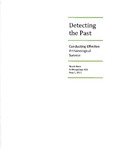Detecting the Past: Conducting Effective Archaeological Surveys (thesis)

View/
Author
Rose, Nicole Anne
Subject
Washington and Lee University -- Honors in Anthropology
Excavations (Archaeology) -- Methodology
Archaeological surveying -- Methodology
Metadata
Show full item recordDescription
Thesis; [FULL-TEXT FREELY AVAILABLE ONLINE] Nicole Anne Rose is a member of the Class of 2011 of Washington and Lee University. How do archaeologists know where to dig? Archaeologists cannot simply label a tract of land an archaeological site and begin excavation. They must follow a long, complicated, and sometimes dull survey process targeted at detecting sufficient cultural remains to designate site status to anyone area on the landscape. Sometimes the site is clearly visible to the naked eye.
Sometimes archaeologists get lucky and detect materials with little work. However, more often than not, archaeologists must approach site discovery through a detailed plan, thought out before the first piece of equipment even enters into a worker's hand. Behind the scenes, researchers consider a long list of variables, from regional environment to past archaeological research, in
order to select the optimal survey methods and sampling strategies for their given project. This paper examines such behind-the-scenes work, using Virginia Piedmont archaeology as a case study, first through previous archaeology in the region and then in a sample survey research proposal. [From the Introduction] Nicole Rose
Collections
The following license files are associated with this item: